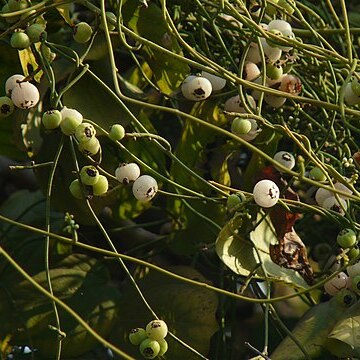Stem (0.2–) 0.5–1.4 mm thick, drying green to reddish brown, young shoots glabrous or red pubescent, becoming glabrescent. Inflorescence a spike, with 3–10 distally crowded or loose flowers, single or rarely paired; peduncle 2–18 mm long, cylindrical or slightly clavate or attenuate when long, sometimes zig-zag, glabrous or with thick short strigose hairs or having long and dense retrorse or antrorse indumentum. Floral bracts whorled; bract triangular, c. 1 × 1 mm, puberulent to glabrous, red-ciliate; bracteoles similar, smaller. Flowers sessile, globose, c. 1.2 mm diam. Sepals triangular, c. 0.5 mm long, mostly glabrous, red-ciliate. Petals ovate, c. 1.1 × 1 mm, glabrous, greenish outside, whitish inside, sometimes slightly red-tinted. Fertile stamens 9, white. Staminodes pyramidal, tip wedge-shaped, c. 0.3 × 0.2 mm, white, occasionally with a white apical gland; glands ovoid or obovoid, c. 0.2 × 0.15 mm, occasionally with a white apical gland. Ovary fusiform, c. 0.9 × 0.4 mm (dried), glabrous. Receptacular tube glabrous inside. Fruit ovoid, 4–6 × 3–4 mm (dried), glabrous or pubescent; hairs adherent, wine-red, drying darker.
More
A plant which keeps growing from year to year by living on other plants. It twines around plants and climbs. It can make some of its own food from carbon dioxide in the air. It attaches to plants by special processes with grow into the plant. The stems are green and become reddish brown when they dry out. They are 0.4-0.5 mm across. If leaves occur they are very small (1 mm) and triangular. Young plants can have hairs but they become hairless. The plant does not have leaves. The flower is a spike. The flowers are white and do not have a flower stalk. The flowers are round and the fruit are pearly pink. They become red when dry. The fruit are 4-6 mm by 3-4 mm. They can be oval or lobed. (It differs from Cassytha filiformis by having a slender almost hairless stem and fruit which are smaller, oval and becoming red when dry.)
A tropical plant. The grow in dry, open, sandy hills. In tropical Queensland it grows from sea level to 600 m altitude. It can grow in arid places.

